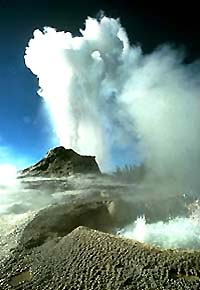| . |  |
. |
 Earthly Microbes Have The ID On ET
Earthly Microbes Have The ID On ETby James E. Kloeppel Champaign - May 2, 2000 - Evidence of life in Martian meteorites or future rock samples from the Red Planet may be easier to identify thanks to microbes living in hot springs at Yellowstone National Park. "The existence of life itself can change the physical and chemical attributes in an environment of deposition," said Bruce Fouke, a geologist at the University of Illinois. "By studying the effects of microbial metabolism on the chemistry of the water and on the way minerals are deposited in Earth environments, we can better interpret samples from other planets for signs of life." For example, various carbonate features -- including tiny, rod-shaped calcite crystals -- found in the Martian meteorite ALH84001 could have been formed by either organic or inorganic means. To help interpret whether such shapes are indicative of life, Fouke has established a systematic model for the deposition of travertine by actively flowing hot springs at Angel Terrace at Mammoth Hot Springs. "Travertine is a crystalline form of calcite that forms where subsurface waters erupt, cool, de-gas and precipitate calcium-carbonate minerals with a variety of crystal morphologies and chemical compositions," Fouke said. "In this setting, we are examining the environmental feedback mechanisms that exist between water, microbes and the precipitation of travertine." Mammoth Hot Springs, near the northern boundary of Yellowstone National Park, is one of the world's largest sites of travertine accumulation. The travertine deposits at Mammoth Hot Springs are approximately 8,000 years old, 73 meters thick and cover more than 4 square kilometers. "Yellowstone is an ideal laboratory because of the high precipitation rates and the abundance of microbes," Fouke said. "By documenting where we find certain calcite shapes in the spring system, we can link those shapes with a particular water flow, chemistry and microbe. With that environmental context, we can start to decipher the geological record and to reconstruct ancient environments." Geochemical evaluation of the spring water and underlying travertine has suggested that inorganic processes such as carbon dioxide de-gassing, temperature decreases and possibly evaporation are the primary environmental controls on travertine mineralogy, Fouke said. "So the environmental context could be the key to determining whether or not a particular feature is an entombed microbe." On Earth, microbes also can be found trapped in fluid inclusions in ancient calcite crystals. Fouke is working with UI microbiologist Abigail Salyers to develop techniques to liberate the microbes and isolate, extract, amplify and sequence their DNA. "The genetic analysis will provide additional information about the microbes' metabolism," he said. "We will incorporate this information into our depositional model to help link the presence of ancient life with suspect, calcium-carbonate depositional features and chemical compositions." Fouke published his findings in the May issue of the Journal of Sedimentary Research. Funding was provided by NASA, the National Research Council and the UI Critical Research Initiative.
THE SEARCH FOR LIFE
|
| |||||||||
| The content herein, unless otherwise known to be public domain, are Copyright 1995-2016 - Space Media Network. All websites are published in Australia and are solely subject to Australian law and governed by Fair Use principals for news reporting and research purposes. AFP, UPI and IANS news wire stories are copyright Agence France-Presse, United Press International and Indo-Asia News Service. ESA news reports are copyright European Space Agency. All NASA sourced material is public domain. Additional copyrights may apply in whole or part to other bona fide parties. Advertising does not imply endorsement, agreement or approval of any opinions, statements or information provided by Space Media Network on any Web page published or hosted by Space Media Network. Privacy Statement All images and articles appearing on Space Media Network have been edited or digitally altered in some way. Any requests to remove copyright material will be acted upon in a timely and appropriate manner. Any attempt to extort money from Space Media Network will be ignored and reported to Australian Law Enforcement Agencies as a potential case of financial fraud involving the use of a telephonic carriage device or postal service. |